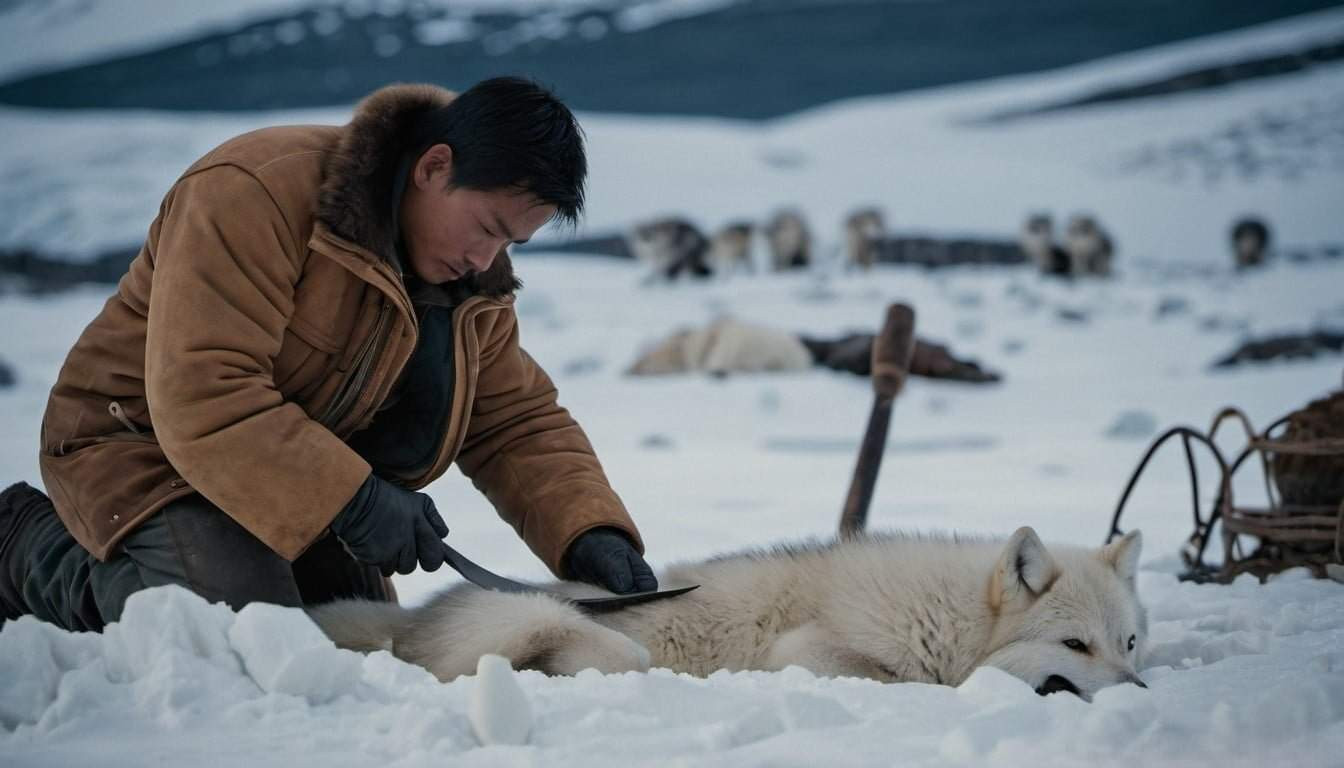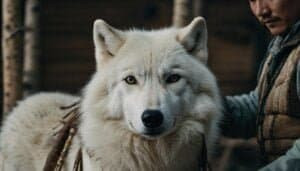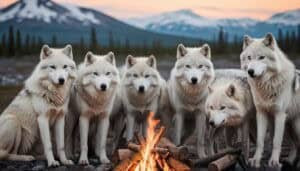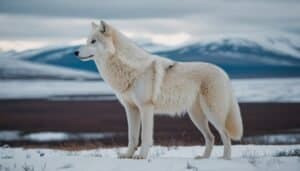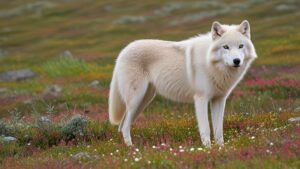Introduction
Traditional Arctic wolf-hide processing techniques have been passed down through generations in indigenous communities, reflecting a deep connection with nature and resourcefulness
This article explores the various traditional methods used in processing wolf hides, from the tools and preparation to the cultural significance and final uses. It also compares these techniques with modern methods, highlighting the differences and the impact on the quality and durability of the hides
Additionally, the skills and time required for these processes, along with the influence of Arctic weather conditions, will be discussed to provide a comprehensive understanding of this intricate craft
Traditional Arctic Wolf-Hide Processing Techniques
Processing Arctic wolf hides traditionally involves a series of intricate steps that reflect the expertise and cultural heritage of indigenous Arctic communities. The techniques have been refined over generations, ensuring that every part of the wolf hide is used efficiently and sustainably
Tools Used in Processing
The tools used in traditional Arctic wolf-hide processing are simple yet highly effective, crafted from materials readily available in the harsh Arctic environment. Key tools include:
Scrapers: Made from bone or antler, scrapers are essential for removing flesh and fat from the hide. The sharp edges allow for precise work without damaging the hide
Frames: Wooden frames are used to stretch and dry the hide. The hide is laced onto the frame to keep it taut, ensuring even drying and preventing shrinkage
Knives: Specialized knives with curved blades are used for delicate tasks such as trimming and final shaping of the hide
Awls and Needles: Bone awls and sinew needles are used for sewing and repairing the hides, turning them into garments or other useful items
Preparing the Wolf Hide
Preparation of the wolf hide is a crucial first step in the processing journey. This involves several key actions:
Initial Cleaning: The hide is first cleaned of blood, dirt, and debris. This is typically done with water and manual scrubbing
Flesh Removal: The flesh and fat are carefully scraped off using bone or antler scrapers. This step requires skill to avoid tearing the hide
Soaking: The hide is soaked in a solution, often made from animal brains or other natural substances, which helps to soften the hide and prepare it for further processing
Tanning Steps Involved
Tanning transforms the raw hide into a durable, pliable material suitable for clothing and other uses. The traditional tanning process involves:
Brain Tanning: A method using the animal’s brains, which contain natural oils and enzymes that soften and preserve the hide. The brains are mashed into a paste and worked into the hide
Smoking: After brain tanning, the hide is often smoked over a fire. The smoke imparts additional preservative properties and gives the hide its characteristic color and scent
Stretching and Drying: The hide is stretched on a frame to dry, ensuring it remains pliable and evenly treated
Preserving the Fur
Preserving the fur is essential for certain uses of wolf hides, particularly in clothing where the fur provides insulation. Key techniques include:
Careful Scraping: When scraping the hide, extra care is taken to avoid cutting the hair roots
Gentle Soaking: Soaking solutions are chosen to maintain the fur’s softness and luster
Proper Drying: The fur side is protected from excessive heat and direct sunlight during drying to prevent damage
Cultural Significance of Wolf Hides
Wolf hides hold deep cultural significance in Arctic communities. They are not only practical but also symbolic:
Traditional Clothing: Wolf hides are used to make warm, durable clothing essential for survival in the Arctic climate
Ceremonial Items: Hides are used in various ceremonial objects and clothing, reflecting respect for the animal and the environment
Storytelling and Heritage: The methods and tools used in processing wolf hides are part of the oral traditions and cultural heritage, teaching younger generations about their history and way of life
Traditional vs Modern Processing Methods
The evolution of wolf-hide processing techniques from traditional to modern methods highlights significant changes in technology, efficiency, and cultural impact
While traditional methods are labor-intensive and deeply rooted in cultural practices, modern techniques offer alternative approaches that can be faster and less physically demanding
Differences in Techniques
Traditional wolf-hide processing techniques differ significantly from modern methods in several ways:
Materials and Tools: Traditional methods use natural materials and handmade tools, such as bone scrapers and wooden frames, whereas modern methods often involve synthetic chemicals and industrial machinery
Processes: Traditional tanning processes, such as brain tanning and smoking, rely on natural substances and manual labor. Modern tanning might use chemical solutions like chromium salts, which can speed up the process but involve synthetic chemicals
Time and Labor: Traditional techniques require significant time and physical effort, with the process often taking several days to weeks. Modern methods can reduce processing time to a matter of hours or days with the use of automated systems and chemical accelerants
Impact on Quality and Durability
The quality and durability of processed wolf hides can vary between traditional and modern methods:
Traditional Methods: Produce hides that are highly durable and well-suited for the harsh Arctic environment. The natural tanning processes result in materials that are flexible and breathable, ideal for clothing and shelter
Modern Methods: Can produce hides quickly and with consistent quality, but they may not always match the durability and environmental suitability of traditionally processed hides. The use of chemicals can also affect the texture and longevity of the hides
Adoption of Modern Methods
The adoption of modern processing methods in Arctic communities varies, influenced by factors such as accessibility, cultural values, and economic considerations:
Accessibility: Modern materials and tools can be more accessible in certain regions, making them a practical choice for some communities
Cultural Values: Many indigenous people continue to prioritize traditional methods, valuing the cultural heritage and sustainability associated with them
Economic Considerations: Modern methods can sometimes reduce costs and labor, making them appealing for large-scale production or commercial purposes
Uses of Processed Wolf Hides
Processed wolf hides have been a vital resource for Arctic communities, serving various practical and cultural purposes. The versatility and durability of wolf hides make them suitable for a range of uses that are essential for survival in the harsh Arctic environment
Clothing and Apparel
One of the primary uses of processed wolf hides is in the creation of clothing and apparel:
Parka Coats: Wolf fur is often used in parkas, particularly for the ruffs around the hoods. The fur provides excellent insulation and protection against wind and cold
Boots and Mittens: The hides are used to make durable, warm boots and mittens, which are crucial for maintaining warmth in freezing temperatures. The fur lining offers additional insulation
Hats and Headgear: Wolf hides are also fashioned into hats and headgear, providing warmth and protection for the head and face, which are exposed to the elements
Tools and Utensils
Beyond clothing, processed wolf hides are used to create various tools and utensils:
Drum Heads: The hides can be stretched and used as drum heads for traditional instruments. The taut, treated hide produces a resonant sound, making it ideal for musical and ceremonial purposes
Cushioning and Binding: The hides are used for cushioning and binding in tools, sleds, and other equipment. The toughness and flexibility of the hide make it a reliable material for these uses
Storage Bags: Wolf hides are also crafted into storage bags that are durable and resistant to harsh conditions. These bags are used to store food, tools, and other essentials
Ceremonial and Cultural Uses
Processed wolf hides play an important role in the ceremonial and cultural practices of Arctic communities:
Ritual Garments: Special garments made from wolf hides are worn during ceremonies and rituals, symbolizing strength, resilience, and the deep connection between the people and their environment
Storytelling: The hides are often decorated and used as visual aids in storytelling, helping to pass down legends, history, and cultural knowledge through generations
Art and Craft: Wolf hides are used in traditional arts and crafts, creating items that are both beautiful and meaningful. These crafts often feature intricate designs and are used in cultural exchanges and displays
Skills and Time Required for Processing
The traditional processing of wolf hides requires a combination of specialized skills and significant time investment. These skills have been passed down through generations and are essential for producing high-quality, durable hides suitable for various uses
Essential Skills for Processing
The processing of wolf hides demands several key skills, each critical to different stages of the process:
Scraping and Cleaning: The ability to efficiently and carefully scrape and clean the hide without damaging it is fundamental. This requires a steady hand and experience with the tools
Tanning Knowledge: Understanding the nuances of traditional tanning methods, such as brain tanning and smoking, is crucial. This includes knowing how to prepare the tanning solutions and the appropriate duration for each stage
Stretching and Drying: Properly stretching and drying the hide on a frame to ensure it remains taut and evenly treated is a specialized skill. It ensures the hide does not shrink or become misshapen
Sewing and Crafting: Once the hide is processed, the ability to sew and craft it into clothing, tools, and other items is essential. This includes knowledge of traditional patterns and techniques
Time Taken for Traditional Processing
The time required to process a wolf hide traditionally can be extensive, reflecting the meticulous nature of the work involved:
Initial Preparation: Cleaning and scraping the hide can take several hours to a full day, depending on the condition of the hide and the skill of the person
Tanning Process: The tanning process, including soaking, brain tanning, and smoking, can span several days to weeks. Each step must be carefully timed to ensure the hide is properly treated
Stretching and Drying: Stretching and drying the hide on a frame can take several days, depending on weather conditions and the specific techniques used
Final Processing: The final steps, including any additional scraping, softening, and crafting into finished products, can take several more days
Influence of Weather Conditions
Weather conditions in the Arctic can significantly affect the hide processing process:
Cold Temperatures: Extremely cold temperatures can slow down the drying process, requiring longer periods for stretching and drying the hide. However, the cold can also help preserve the hide during initial cleaning and scraping
Humidity: High humidity can impede the drying process and may require additional steps to ensure the hide does not develop mold or rot. In contrast, low humidity can expedite drying but requires careful monitoring to prevent over-drying and cracking
Wind and Sun: Wind can aid in the drying process by providing ventilation, but it can also cause uneven drying if not monitored carefully. Direct sunlight can damage the hide by causing it to dry too quickly, leading to brittleness and cracking
Conclusion
Traditional Arctic wolf-hide processing techniques are a testament to the ingenuity and resourcefulness of indigenous Arctic communities
These methods, which involve specialized tools, meticulous preparation, and natural tanning processes, produce high-quality hides that are integral to the culture and survival of these communities. The uses of processed wolf hides are diverse, ranging from practical clothing and tools to ceremonial items and cultural artifacts
Despite the introduction of modern processing methods, many communities continue to preserve and practice these traditional techniques, valuing their sustainability, cultural significance, and superior quality
The skills required for traditional wolf-hide processing are honed through generations of practice, and the process is deeply influenced by the harsh Arctic environment
Understanding and appreciating these traditional techniques not only highlights the cultural heritage of Arctic peoples but also underscores the importance of preserving such knowledge for future generations
The balance between maintaining traditional practices and adapting to modern innovations reflects the dynamic and resilient nature of Arctic cultures
